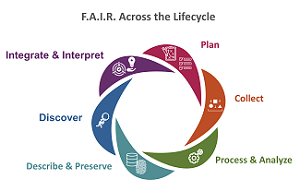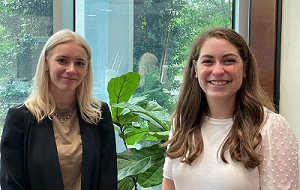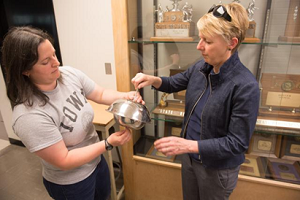Science Leadership
Superfund Research Program (SRP) staff and grantees are committed to advancing SRP research by presenting innovative findings, tools, and technologies to stakeholders in academia, government, and local communities.

SRP staff published a Perspective in Environmental Science & Technology synthesizing the experiences of 19 collaborative projects focused on data management and integration to advance the interoperability and reuse of diverse SRP data streams. The publication describes common challenges and opportunities to address complex environmental health problems through integrating data.
SRP Director William Suk, Ph.D., M.P.H., wrote an invited perspective for the journal Environmental Health Perspectives noting how health data analyses can illustrate the public health benefits of environmental remediation. He also explained how data science initiatives that transcend scientific disciplines can inform better solutions to longstanding and emerging environmental health problems alike.
SRP Health Scientist Administrator Heather Henry, Ph.D., worked closely with the Federal Remediation Roundtable (FRTR) to plan their Summer 2022 meetings, held June 6 and 13. The meetings focused on leveraging advances in machine learning and artificial intelligence to improve current environmental remediation strategies. Henry, who is a member of the FRTR steering committee, also shared relevant SRP-funded research on the topic.
Henry also participated in the virtual workshop "Toxic Elements in Food: Identification of Critical Knowledge Gaps to Ensure a Safe Food Supply." The meeting was coordinated by SRP individual research project grantees Om Parkash Dhankher, Ph.D., of the University of Massachusetts, Amherst, and Jason White, Ph.D., of the Connecticut Agricultural Experimental Station, in conjunction with the U.S. Department of Agriculture and the U.S. Food and Drug Administration. The workshop, which attracted several experts in the area of plant-metal interactions, aimed to minimize metals in food, particularly baby food.
SRP Health Scientist Administrator Michelle Heacock, Ph.D., is co-chair of a working group focused on identifying connections between cancer and environmental exposures. The working group is a partnership between NIEHS and the National Cancer Institute.
SRP Health Scientist Administrator Danielle Carlin, Ph.D., co-chaired a session at the Society of Toxicology conference in late March about the challenge of studying the human and ecological effects of exposures to multiple stressors - including chemical mixtures, heat stress, and socio-economic disparities - through the lens of extreme weather. Carlin is also part of an NIEHS working group that is studying the health impacts of exposure to chemical mixtures.
SRP is delighted to welcome two talented interns to the team, who will work closely with SRP staff this summer:

- Kirsten Reid, a second year MPH student at Emory University focusing on Behavioral Social and Health Education Sciences, will work Henry on per- and polyfluoroalkyl projects as well as an initiative on metals in infant formula.
- Anna Kremer, a second year MPH student at Saint Louis University focusing on Epidemiology and Health Management and Policy, will work on data sharing policy and management with Heacock.
SRP was well represented at the Society of Environmental Toxicology and Chemistry's meeting focused on Nontarget Analysis for Environmental Risk Assessment, held May 22-26. Several SRP researchers gave scientific presentations, including:
- Lee Ferguson, Ph.D., of the Duke University SRP Center.
- Erin Baker, Ph.D., of the North Carolina State University SRP Center.
- Thomas Young, Ph.D., of the University of California, Davis SRP Center.
- Sara Nason, Ph.D., Connecticut Agricultural Experiment Station.
SRP-funded researchers were recently featured in NIEHS highlights:
-

University of Iowa SRP Center researcher Rachel Marek, Ph.D., left, and Hornbuckle, right, use a hollow steel ball lined with small discs of polyurethane foam to collect PCBs in air. (Photo courtesy of the University of Iowa) Keri Hornbuckle, Ph.D., director of the University of Iowa SRP Center, and her team were featured in an SRP public health impact story about their pivotal research on polychlorinated biphenyls. Their work is informing policies and strategies to clean up these contaminants in air, including at Superfund sites and in schools.
- Stefano Monti, Ph.D., who has led the Bioinformatics and Molecular Modeling Core at the Boston University SRP Center since 2012, explained how he is developing computational models for environmental contaminants to predict their long-term health effects, such as cancer and metabolic disorders.
- Former Columbia University SRP Center trainee Tiffany Sanchez, Ph.D., reflected on her experience as a trainee working with large cohorts, or groups of participants, to understand the connections between metal exposures and disease.
- University of Alabama, Birmingham, SRP Center Director Veena Antony, M.D., described her work to improve lung health in residents near a local Superfund site.
- Kathleen Gray, Ph.D., who leads the Community Engagement Core at the University of North Carolina at Chapel Hill SRP Center, shared how she is helping communities better understand how the environment can affect their health.
- University of Arizona SRP Center Community Engagement Core lead Karletta Chief, Ph.D., explained her work to understand and address impacts on water sources from both environmental contamination and extreme weather events.
to Top



